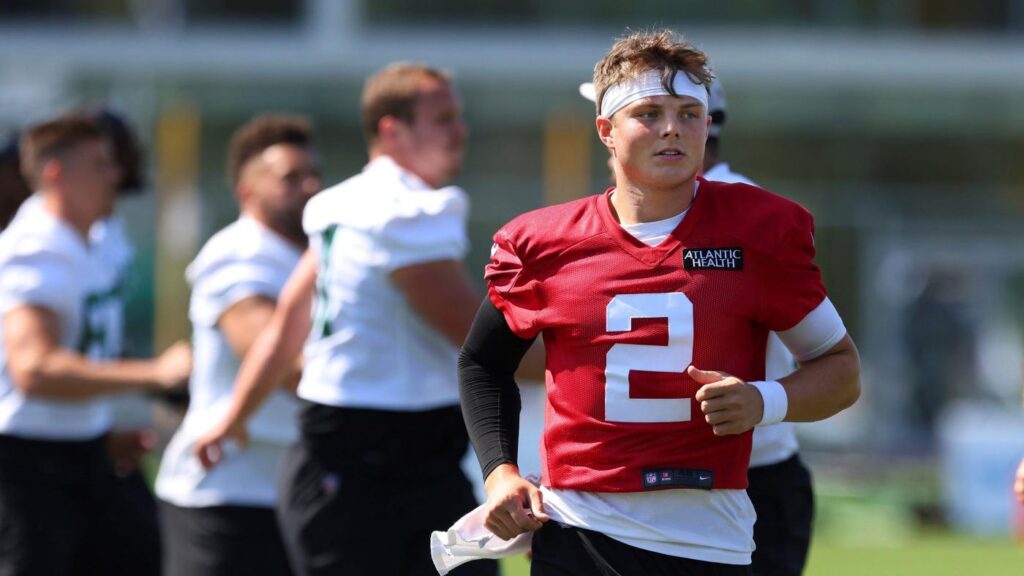
Get ready Jets fans. Phase three of Gang Green’s offseason has started with OTA’s kicking off this week.
The Jets entered the offseason with a plethora of assets to infuse their roster with talent and they succeeded in acquiring players who can supercharge their rebuild after finishing 4-13 in 2021.
The Jets have 10 OTA practices over the next three weeks, which are all voluntary. Then mandatory minicamp begins from June 14-16.
Robert Saleh said there won’t be as many 11-on-11 sessions to lessen the load on the defensive and offensive linemen, which means more 7-on-7.
But here are the two more intriguing storylines to follow during OTAs.
IMPROVED WILSON IN YEAR TWO
Around this time last year, Wilson joined the Jets as the No. 2 pick — after dominating in his final year at BYU — and big expectations were made.
Wilson will enter the coming season with legitimate questions surrounding him after a rough first year, in which he tossed nine touchdowns, 2,334 yards passing with 11 interceptions, and completed 55% of his passes.
The second year QB won’t be graded with the rookie curve anymore. He must hasten his development with the Jets in year two of their rebuild if they hope to one day be AFC contenders. OTAs will be a decent checkpoint to evaluate his growth.
There isn’t much within OTAs that will positively or negatively quell the questions though. If Wilson looks terrible, it wouldn’t be an indictment and if he tears up the Jets defense, it wouldn’t put him in the Hall of Fame.
Wilson will have days when he produces tantalizing throws as he’s lightly pressured by the defense — no pads means a lower level of difficulty for QBs.
But what is most important is how Wilson’s mental processing looks. He must orchestrate the offense by showing strong command of the playbook and guiding his teammates into the right spots.
And he should go through his progressions with a higher level of efficiency, reducing the amount of time he holds the ball while reading the defense before firing bullets across the field. That’s something he struggled with last year.
Those small details matter way more and are harder to catch during non-padded practice.
What should help is the improved pass catching talent around him, the three receivers who could objectively demand No. 1 receiver targets: Corey Davis; Elijah Moore, a second year promising talent; and Garrett Wilson, the No. 10 overall pick in 2022. Free-agent signings Tyler Conklin and C.J. Uzomah should revive the Jets tight end position — which was a wasteland over the last a decade — as Conklin and Uzomah combined last season for 110 catches, 1,086 yards and eight touchdowns.
These are the building blocks of Wilson’s continued development into the franchise’s guy.
REED AND SAUCE
The Jets revamped their cornerback room when they added D.J. Reed and the 2022 No. 4 overall pick, Cincinnati’s Ahmad “Sauce” Gardner.
During OTAs, all eyes will be on this duo to flash the playmaking ability that led to the Jets acquiring them. Gardner and Reed must challenge the Jets starting trio of Garrett Wilson, Davis and Moore and make Zach Wilson’s life slightly harder during practice.
It’ll make both parties better.
Last season, the Jets had Bryce Hall, Brandin Echols, Isaiah Dunn, Javelin Guidry and Michael Carter II at cornerback. It was a decent group, but Jets brass knew the unit still needed to be addressed.
When QBs threw to wide receivers outside numbers last year, the Jets allowed 1,419 yards, fourth most in the NFL, according to Next Gen Stats. Along with a passer rating of 101, ninth highest.
Another issue was defending on third down.
When QBs targeted Hall in those instances, QBs had a passer rating of 129 as he allowed three touchdowns and 22 receptions on 31 targets. Echols allowed a passer rating of 96 with 11 receptions on 18 targets but didn’t allow a touchdown.
With Reed and Gardner in the mix, those issues could dramatically improve.
Reed — who agreed to a three-year free agent deal with the Jets — finished with two interceptions and 10 pass breakups in last season.
QBs completed 49% of their passes when throwing in his direction, which was fifth lowest among CBs. QBs also finished with a passer rating of 69 when they threw in Reed’s direction and he allowed only three touchdowns and 474 yards in coverage.
Reed’s strongest trait was in zone coverage. He logged a passer rating of 67.6 in zone, which was 27th best among corners, according to Pro Football Focus. He allowed 30 receptions for 338 yards and one touchdown.
The 6-2, 190-pound cornerback was viewed as arguably the best corner prospect in the draft. Gardner is a long physical with elite athleticism and he allowed zero touchdowns in his college career.
()
